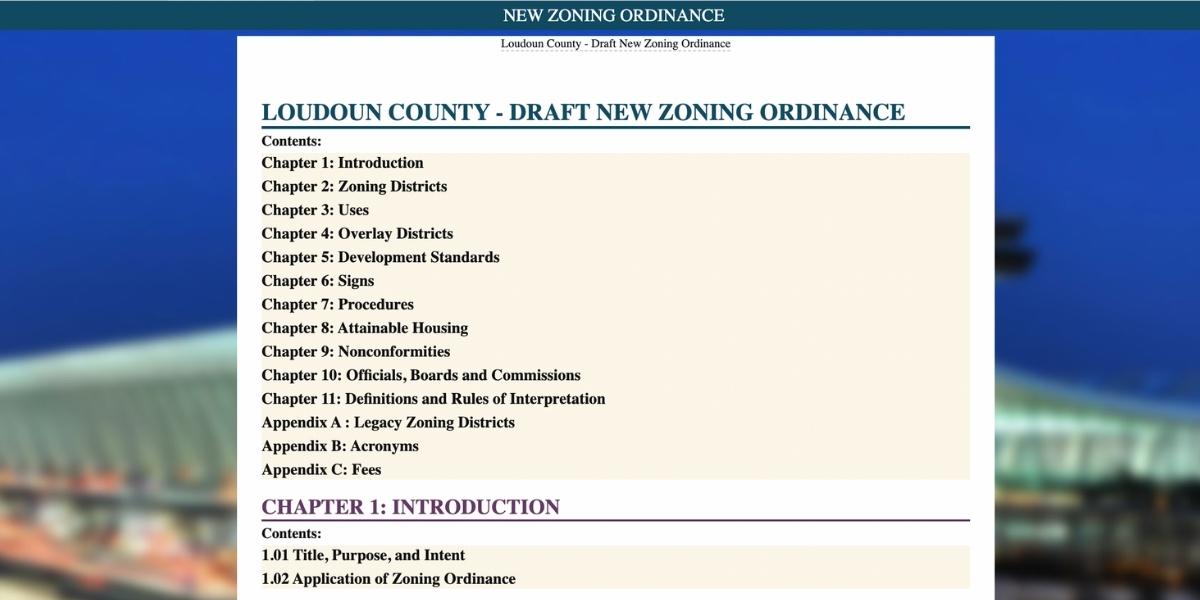The following text was sent out via email on July 11, 2022. Sign up for PEC email alerts →

Dear Supporter,
Have you heard that Loudoun County is rewriting its zoning ordinance? It was last updated in 2003, and since then, a lot has changed. The County population and number of households have doubled, a new Urban Policy Area was added with metro access coming soon, housing affordability has become a much bigger problem, and the County is recognizing a responsibility to address equity issues and climate impacts. And these are just a few of many changes in Loudoun County over the last 20 years, making a zoning ordinance update all the more important.
Since we are in the early public process of this revision, I want to share some background on the ordinance, including a few highlights and areas where we have concerns, and encourage you to share your own perspective with County leaders.
What is a zoning ordinance and why should you care?
The zoning ordinance directs how much, where and what type of development can occur. It controls how land is managed and how natural resources and historic resources are protected. It establishes requirements for affordable housing and strategies for ensuring sustainability, and so on.
Importantly, the zoning ordinance provides many specific details on how the County can accomplish these and other land use objectives, and is a key document that regulates how development must occur to implement the vision outlined in the Comprehensive Plan.
Loudoun’s Comprehensive Plan was last updated in 2019, and since then, staff and consultants have been drafting a zoning update to ensure its vision translates into reality on the ground. Their work has included:
- Collecting input from many groups
- Working with the Zoning Ordinance Committee (ZOC), which is comprised of people representing a wide variety of community perspectives, including PEC, as an advisory body and sounding board
- Drafting and revising text repeatedly in the first steps toward creating the new ordinance
The first draft is now available for public input and comments will be accepted through July 18, 2022 – keep scrolling for all the ways you can make your voice heard during this process.

What’s in the rewrite?
The current draft of the ordinance includes some improvements for specific zoning requirements, including:
- Greater stream and other sensitive resource protection
- Walkability and trail connections
- Rebalancing parking requirements for residential and commercial developments
- The use of native plants
- The removal of invasive and noxious plants
There are still other zoning needs that we feel should be addressed, such as:
- Ensuring that uses (e.g. event centers of any kind, wineries, breweries) with similar offsite impacts have consistent standards on noise, lighting, traffic, etc.
- More natural and historic resource protection during the development process
- More farmland protection with rural economy uses
- More standards to reduce climate and environmental impacts of development
- Greater affordable housing requirements
- Better sign standards
- Increased lighting standards
What about density reductions in the Rural Policy Area?
The Board of Supervisors has chosen not to address rural zoning densities in this zoning ordinance rewrite. A downzoning, which would reduce densities in the rural districts, would be a major undertaking requiring the County to first revisit and amend the Comprehensive Plan. If the County Board and staff were to pursue a Comprehensive Plan amendment and zoning ordinance change now to reduce densities, all of the other needed improvements would be further delayed. Although this zoning rewrite does not address downzoning, there is still significant work continuing on another portion of the zoning related to prime agricultural soils and cluster subdivisions that could reduce development impacts in the Rural Policy Area. And we strongly advocate for the Board to take up, adopt and fund whatever is necessary to restart the Purchase of Development Rights (PDR) program. Stay tuned!
How can I get involved?
If you care about these kinds of issues, I’d encourage you to help County staff understand what’s important to you in one of three ways:
- Send an email to zorewrite@loudoun.gov or call (703) 777-0246.
- Fill out the online form with comments or concerns.
- Make specific and direct comments on the Draft Zoning Ordinance using a new online tool.
Although the zoning ordinance is about 1,000 pages long, it’s worth a scan regardless of whether you intend to provide edits directly on the text or will be contacting staff through the online form, by phone or email.
Note: After July 28, 2022, the Draft Zoning Ordinance is only available for viewing through the Loudoun Online Land Application System (LOLA).
What are the next steps?
Using your input and that of other community members, the County will produce a second draft of the zoning ordinance for a Planning Commission public hearing set for August 30. This will mark the start of the official public process required by state code. We hope you’ll plan to attend.
PEC has been involved from the start of the zoning ordinance rewrite, providing input to the County on issues related to land use and appropriate uses, land conservation, community design, public access to nature, affordable housing, and more.
In August, when the second draft is released to the public, we will be able to identify a more specific set of outstanding issues that require further comment; be sure to check back for an email update.
As always, please reach out with any questions or concerns. I would be happy to discuss the details with you!
Sincerely,
Gem Bingol
Loudoun County Field Representative
gbingol@pecva.org
(540) 347-2334 ext. 7041
